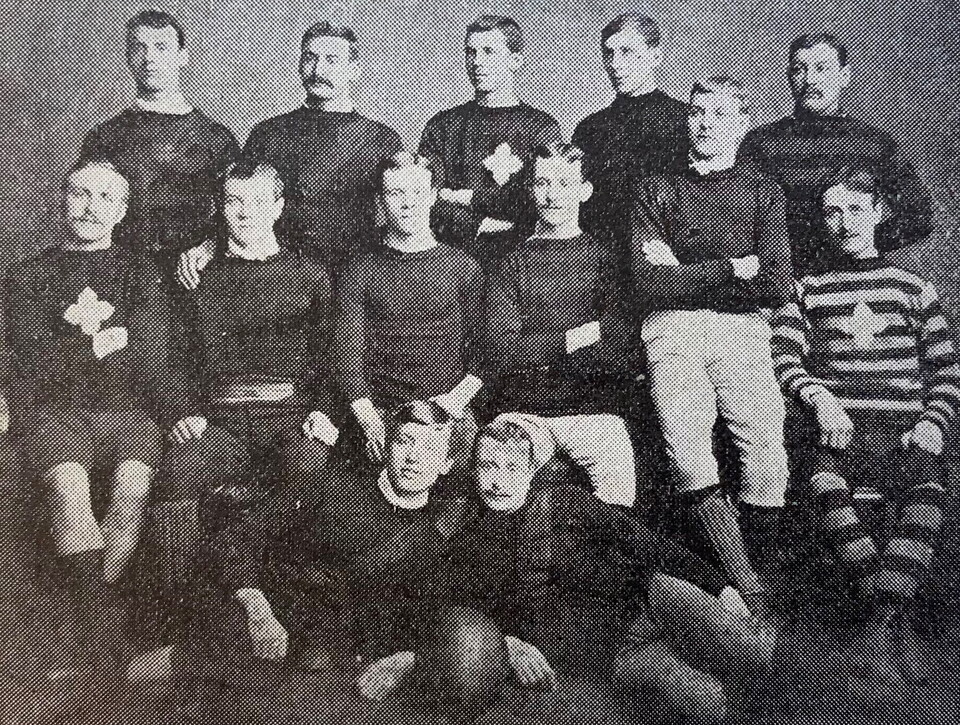Club Historian Graham McKechnie profiles Jim Barker, a crucial figure – yet often forgotten – in the long history of Northampton Saints.
Jim Barker was a normal working man from St James. He lived in a terraced house on Ambush Street, having moved there from Weedon as a teenager. He was a painter and decorator, and spent just about his entire life in and around Jimmy’s End.
When he died in 1929 he was buried in Dallington Cemetery in a modest grave, sharing the plot with his wife Catherine. He had no children and slowly he slipped into anonymity – a forgotten life of an ordinary man from Victorian England.
Except there is a reason for Jim Barker to be remembered. A very significant reason. From Monday to Friday he was a painter and decorator, but on a Saturday afternoon he was a Saint; the very first captain of the Club.
St James was a slum when Jim Barker arrived there in the mid-1870s. It was a major cause of concern. The commissioners of a report in 1879 concluded that, “We shall be justified in using the expression, ‘Waiting for the Plague’…Filth, overflowing middens, lagoons of liquid sewage, an absence of drainage, filthy houses, poverty…the most scandalously insanitary of rural districts: St James’ End, Northampton”.
Ambush Street was in the heart of this slum – Jim lived at number 49 with the Grose family. But it was in these cramped streets that the Club grew. Jim, like other like-minded young men in the area, attended St James Church. He sang in the choir and he met Reverend Samuel Wathen Wigg and joined the Improvement Class in 1878.
While the class taught the young men about the Bible, they also started to play some rugby on the fields around Jimmy’s End, behind the pub which is today called The Sevens. They hung their coats in a cow shed in the corner of the field and let off steam. It was of a rough and informal nature to begin with, until in 1880, Northampton St James was officially born as a club. Jim was elected as captain.

Saints wore red jerseys with black shorts in that first season – the games were played in various parts of town: the Racecourse and fields behind The Green Man which doubled up as their changing rooms (now The Thomas A Becket).
There are no records of their opponents or their results, but Jim recalled in later years that they played other local clubs such as The Star, Unity, Scorpions and Long Buckby. He was a forward – positions in the pack were not yet defined. And his stature suggests he had some power; he stood at just 5’8” but weighed an impressive 15 stone. “He carries evidence of the fierce character of the scrummaging of those times – both his ears are broken and he can twist them as though they were wire,” wrote a reporter for the Northampton Mercury in 1927.
Jim himself spoke to the paper that year. “We paid our own expenses,” he said. “And often those of us who were better off would pay for the poorer members of the side as well. If the club we chose to visit chose to give us tea, all well and good; if not we had to buy it for ourselves. To places which could not be reached by rail we journeyed in brakes, and some cold, wet rides we had too. Very often, also, we have changed in the train to be on time for the kick-off.
By the time they moved to Franklin’s Gardens in 1888, they would still change at The Green Man. A St James resident recalled as an old man in the 1970s watching Saints running down St James Road and onto Weedon Road, “passing a football to fro, and it being Saturday, cattle and other farm stock moving out of the town on the hoof from Northampton Cattle Market could add interest and excitement to Saints’ passing movements.”
Jim did the job for just one year – that first season in 1880. He continued to play into the 1890s and after that remained a presence at Franklin’s Gardens as a committeeman and elder statesman of the club. His wife Catherine died in 1927 – she was a Grose, they married while he was the family’s lodger.
In his last years there wasn’t much decorating work for him around St James, although he found a little extra by helping out with the Boys’ Brigade and he still shuffled along from Ambush Street to watch his beloved Saints. “I sometimes feel I would dearly love to play again and help the Saints,” he said in later life – a sentiment shared by every former player down the years.
He died on 1 February 1929. The funeral service was of course held in St James Church before he was laid to rest in Dallington Cemetery, with a wreath of green and black left on top of the grave.
Jim has been almost entirely forgotten. His grave is covered in moss and weeds, the stone bearing his name lies at a precarious angle and there is no headstone.
It is time that Jim Barker is remembered properly for who he was and for what he represents; a working man who did something extraordinary, the embodiment of the early values and the spirit of the Saints, a spirit that still resonates today.



